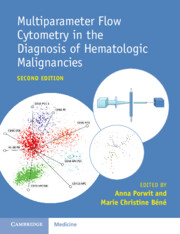Book contents
- Multiparameter Flow Cytometry in the Diagnosis of Haematologic Malignancies
- Multiparameter Flow Cytometry in the Diagnosis of Haematologic Malignancies
- Copyright page
- Contents
- Contributors
- Preface
- Abbreviations
- Chapter 1 Flow Cytometry in Clinical Haematopathology
- Chapter 2 Antigens
- Chapter 3 Flow Cytometry of Normal Blood, Bone Marrow and Lymphatic Tissue
- Chapter 4 Reactive Conditions and Other Diseases Where Flow Cytometric Findings May Mimic Haematological Malignancies
- Chapter 5 Examples of Immunophenotypic Features in Various Categories of Acute Leukaemia
- Chapter 6 Acute Lymphoid Leukaemia and Minimal/Measurable Residual Disease
- Chapter 7 Immunophenotyping of Mature B-Cell Lymphomas
- Chapter 8 Plasma Cell Myeloma and Related Disorders
- Chapter 9 Mature T-Cell Neoplasms and Natural Killer-Cell Malignancies
- Chapter 10 Flow Cytometric Diagnosis of Classic Hodgkin Lymphoma in Lymph Nodes
- Chapter 11 Measurable Residual Disease in Acute Myeloid Leukaemia
- Chapter 12 Ambiguous Lineage and Mixed Phenotype Acute Leukaemia
- Chapter 13 Flow Cytometry in Myelodysplastic Syndromes
- Chapter 14 Future Applications of Flow Cytometry and Related Techniques
- Index
- References
Chapter 1 - Flow Cytometry in Clinical Haematopathology
Basic Principles and Data Analysis of Multiparameter Data Sets
Published online by Cambridge University Press: 30 January 2025
- Multiparameter Flow Cytometry in the Diagnosis of Haematologic Malignancies
- Multiparameter Flow Cytometry in the Diagnosis of Haematologic Malignancies
- Copyright page
- Contents
- Contributors
- Preface
- Abbreviations
- Chapter 1 Flow Cytometry in Clinical Haematopathology
- Chapter 2 Antigens
- Chapter 3 Flow Cytometry of Normal Blood, Bone Marrow and Lymphatic Tissue
- Chapter 4 Reactive Conditions and Other Diseases Where Flow Cytometric Findings May Mimic Haematological Malignancies
- Chapter 5 Examples of Immunophenotypic Features in Various Categories of Acute Leukaemia
- Chapter 6 Acute Lymphoid Leukaemia and Minimal/Measurable Residual Disease
- Chapter 7 Immunophenotyping of Mature B-Cell Lymphomas
- Chapter 8 Plasma Cell Myeloma and Related Disorders
- Chapter 9 Mature T-Cell Neoplasms and Natural Killer-Cell Malignancies
- Chapter 10 Flow Cytometric Diagnosis of Classic Hodgkin Lymphoma in Lymph Nodes
- Chapter 11 Measurable Residual Disease in Acute Myeloid Leukaemia
- Chapter 12 Ambiguous Lineage and Mixed Phenotype Acute Leukaemia
- Chapter 13 Flow Cytometry in Myelodysplastic Syndromes
- Chapter 14 Future Applications of Flow Cytometry and Related Techniques
- Index
- References
Summary
This chapter is an introduction to flow cytometry aimed at newcomers in the field but also intended as a refresher for seasoned flow cytometrists confronted with unexpected data related to physical interferences, compensation problems, autofluorescence or aiming at harmonising instruments. It also provides counsel on panel building, sample handling and data display, fundamental points to consider in setting up new protocols.
Keywords
- Type
- Chapter
- Information
- Publisher: Cambridge University PressPrint publication year: 2025

